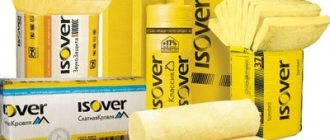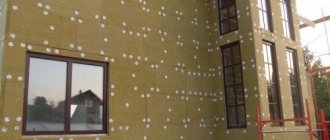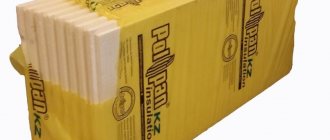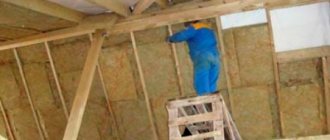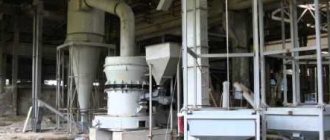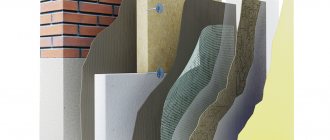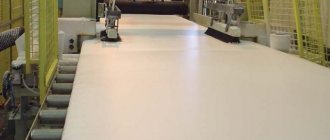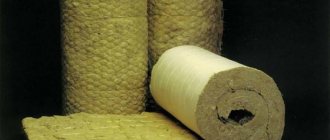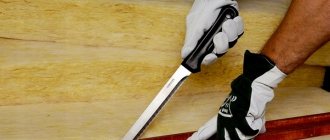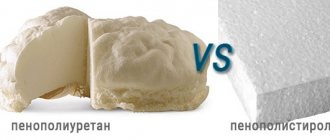Main advantages of the material
Tekhnoruf insulation has numerous advantages, the most important of which are given below.
- Possibility of effective roof insulation.
- Long service life.
- Possibility of installation on an unleveled surface. In addition, the screed is also not a prerequisite.
- All installation steps can be completed by yourself.
- After insulation, the roof can be used as a floor, even without installing a concrete screed on top of the material.
- No special equipment is used in the work.
- There are no wet processes during installation.
- Finally, the duration of installation work is insignificant.
Note! This insulation can be laid on any surface - corrugated board, concrete, sheet steel and even cement screed. But at the same time, neither leveling the surface nor using polymer glue for fixation is required.
Types of insulating material
There are several product lines, let's get acquainted with the features of each of them.
Actually, Technoruf
This is how we decided to call the modification of the material, which can be used for insulation without any additions, that is, alone. This material is intended for use as the main thermal insulation layer for all types of roofing, regardless of what material the surface is made of. The dimensions of the products in this case are as follows (LxWxT): 100/120x50/60x5-11 centimeters. As for specific modifications, they are listed below (for the convenience of visitors, the information is presented in the form of a small table).
Table No. 1. Technical characteristics of the Tekhnoruf heat insulator
| Index | Tekhnoruf 45 | Tekhnoruf 50 | Tekhnoruf 60 | Tekhnoruf 70 |
| Density kg/m3 | 140 | 160 | 170 | 180 |
| Compressive density at 10% strain | 45 | 50 | 60 | 70 |
| Peel strength of layers kPa no less | 10 | 10 | 10 | 10 |
| Thermal conductivity at 10 C no more | 0,037 | 0,037 | 0,037 | 0,037 |
| Thermal conductivity at 25 C no more | 0,039 | 0,039 | 0,039 | 0,040 |
| Thermal conductivity under operating conditions A | 0,043 | 0,043 | 0,043 | 0,044 |
| Thermal conductivity under operating conditions B | 0,046 | 0,046 | 0,046 | 0,047 |
| Vapor permeability | 0,3 | 0,3 | 0,31 | 0,32 |
| Humidity by mass% no more than | 0,5 | 0,5 | 0,5 | 0,5 |
| Water absorption by volume % no more | 1,5 | 1,5 | 1,5 | 1,5 |
| Content of organic substances % no more | 4,5 | 4,5 | 4,5 | 4,5 |
| Flammability degree | NG | NG | NG | NG |
It is worth noting that all these products have been on sale since 2007.
Technoruf N
Such modifications are also suitable for any surface, but are intended for installation in combination with the insulation described below (we are talking about modifications B). They have excellent noise, thermal and moisture insulation properties, but, being not strong enough, they need to be “protected” by a more durable material. Dimensions of material slabs (LxWxT): 100/120x50/60x5-11 centimeters. The main parameters are given below.
Table No. 2. Technical characteristics of the Tekhnoruf N heat insulator
| Index | Tekhnoruf 25 | Technoruf H30 | Tekhnoruf 35 | Tekhnoruf 40 |
| Density kg/m3 | 95 | 100 | 110 | 120 |
| Compressive density at 10% strain | 25 | 30 | 35 | 40 |
| Thermal conductivity at 10 C no more | 0,036 | 0,036 | 0,036 | 0,036 |
| Thermal conductivity at 25 C no more | 0,039 | 0,039 | 0,039 | 0,040 |
| Thermal conductivity under operating conditions A | 0,042 | 0,042 | 0,042 | 0,042 |
| Thermal conductivity under operating conditions B | 0,045 | 0,045 | 0,045 | 0,045 |
| Vapor permeability | 0,29 | 0,3 | 0,3 | 0,31 |
| Humidity by mass% no more than | 0,5 | 0,5 | 0,5 | 0,5 |
| Water absorption by volume % no more | 1,5 | 1,5 | 1,5 | 1,5 |
| Content of organic substances % no more | 4,5 | 4,5 | 4,5 | 4,5 |
| Flammability degree | NG | NG | NG | NG |
Tekhnoruf V
Tekhnoruf insulation is similar in its properties, which, however, has higher strength. For this reason, it should be used as the top layer of a thermal insulation cake. Let's get acquainted with the main parameters.
Table No. 3. Technical characteristics of Tekhnoruf V
| Index | Technoruf B 50 | Tekhnoruf B 60 | Tekhnoruf B 70 |
| Density kg/m3 | 170 | 180 | 190 |
| Compressive density at 10% strain | 50 | 60 | 70 |
| Thermal conductivity at 10 C no more | 0,037 | 0,037 | 0,037 |
| Thermal conductivity at 25 C no more | 0,040 | 0,040 | 0,040 |
| Thermal conductivity under operating conditions A | 0,043 | 0,043 | 0,045 |
| Thermal conductivity under operating conditions B | 0,046 | 0,046 | 0,046 |
| Vapor permeability | 0,30 | 0,31 | 0,35 |
| Humidity by mass% no more than | 0,5 | 0,5 | 0,5 |
| Water absorption by volume % no more | 1,5 | 1,5 | 1,5 |
| Content of organic substances % no more | 4,5 | 4,5 | 4,5 |
| Flammability degree | NG | NG | NG |
As a rule, of all the described modifications, these are the most often used - H30 and B60. Installing double insulation generally allows you to achieve maximum effect. For convenience, each layer is labeled separately.
How to calculate the thickness of insulation
Previously, we talked about and gave examples of calculating the thickness of insulation; in addition to this article, we advise you to read this information and read about it here
Modification H30
Intended (and actively used) for roof insulation and sound insulation. The vapor permeability of the material is quite low, as is the compressive strength (this means that it is installed in tandem with denser modifications). In general, the material is quite effective and durable.
As for specific technical information, it is given below.
- The insulation is not flammable.
- Its thermal conductivity can reach 0.045 watts/cubic meter.
- Its moisture absorption is 1.5 percent.
- The strength indicator is 30 kilopascals.
- The concentration of organic matter is 4.5 percent of the total mass.
- The density of the heat insulator is 100 kilograms/cubic meter.
- Finally, the moisture level does not exceed 0.5 percent of the total mass.
Modification B60
Another type of material that is very popular. It is used as a top layer, as it is characterized by increased compressive strength. This ensures the required rigidity of the entire coating.
As noted above, this material can be used both for metal surfaces and reinforced concrete, and it does not require any preliminary screed. And there is no need to cover it with a screed either, thanks to which the surface is able to withstand the most significant point loads. Thanks to the use of insulation as thermal insulation for roofs, a durable surface is provided that is waterproof and wear-resistant, as well as the ability to retain most of the thermal energy.
As for the specific parameters, they look approximately as follows.
- The insulation is not flammable.
- Its thermal conductivity can reach 0.046 watts/cubic meter.
- Its moisture absorption is 1.5 percent.
- The strength indicator is 60 kilopascals.
- The concentration of organic matter is 4.5 percent of the total mass.
- The density of the heat insulator is 180 kilograms/cubic meter.
- Finally, the moisture level does not exceed 0.5 percent of the total mass.
Specifications
The operational and technical parameters of the material comply with Russian GOST and are checked in accordance with the standards. The main data is presented in the table.
| Parameter | Meaning |
| Specific Gravity | 170 kg/m3 |
| Resistance to linear deformation | 60 N/cm |
| Thermal conductivity value | 0.038 W/m-K |
| Vapor tightness indicators | 0.3 mg/(m*h*Pa) |
| Moisture absorption | 1.5% of total volume |
| Humidity | No more than 0.5%. |
| Organic content | No more than 4.5% |
| Width | 600 mm |
| Length | 1 200 mm |
| Thickness | 40 mm |
The homeland of the brand is Russia, the material is intended for free installation.
Installation Features
Let’s immediately say that installing the heat insulator described in the article is a fairly simple procedure. First, the working surface is thoroughly cleaned of all foreign objects present on it. After this, a vapor barrier layer is laid over the entire area (both a polymer membrane and bituminous materials can be used as such). The joints between the strips of insulating material are glued using mounting tape.
Note! The insulation boards themselves should be laid in a checkerboard pattern (that is, so that the joints of adjacent rows do not coincide). To fasten the material, special telescopic dowels should be used (approximately two to three units for each of the insulator plates).
For a more detailed understanding of the installation process, we recommend that you read the step-by-step instructions below. As you can see, it is quite short, which is another proof of the ease and simplicity of the process. The algorithm of actions should be as follows.
Step one. The working surface is thoroughly cleaned of all foreign objects on it, as well as dirt and debris.
Step two. A vapor barrier material is laid around the entire perimeter (as such, as noted above, both polymer membranes and bitumen-based insulators can be used). The joints between the strips are glued using mounting tape, and the strips themselves are laid with an overlap. It is also worth noting that the vapor barrier should be installed on the sides of the roof to the height of the entire thickness of the insulating pie plus 20 millimeters.
Step three. Plates of insulating material (modification H, although in most cases H30 is used, as far as we already know) are laid on top of the vapor barrier. Laying is done in a checkerboard pattern - the same way, for example, bricks are laid (the joints of adjacent rows should not coincide). To fasten the insulation, special telescopic dowels are used (two units for each of the plates, although you can increase the strength and use three or even four).
Step four. Modification B slabs are installed on top of the lower insulating layer (they are intended for the top layer of the cake); in this case, telescopic dowels made of nylon are used for fixation. The joints in this case are also tied (in other words, the joints of the lower row should be located approximately in the center of the slabs of the upper row - they seem to overlap). The specific type of dowel anchor elements should be selected according to the floor material in each particular case.
Step five. A waterproofing material is laid on top of the insulation (the best option is a polyvinyl chloride membrane).
Note! Places of contact with sides or pipes, as well as various slopes, are organized using special additional/shaped components, which were also provided by the manufacturer. These components are also made of basalt wool, so they can be used for arranging roofs of various shapes.
As you can see, no specific skills or knowledge are required here. The only thing that may be difficult is the installation of a PVC membrane, since this will require experience in working with similar materials, as well as welding work.
Video - Installation of Tehnoruf insulation
TechnoNIKOL Technoruf V60
Thermal insulation boards Tekhnoruf B60 are successfully used for insulating flat roofs in combination with mineral wool boards Tekhnoruf N30. The slabs are intended for use as the top layer in coatings made of reinforced concrete or corrugated sheets, the so-called two-layer insulation system. Tekhnoruf B insulation has high compressive strength, which is an important indicator when installing and operating flat roofs. Finish coatings such as bitumen waterproofing, PVC, EPDM, TPO membranes are easily applied to the products. The savings when using Tekhnoruf N and Tekhnoruf V slabs are justified and are one of the most common roof insulation systems. The high insulation density of 180 kg/m3 and compressive strength of 60 kPa provide the most required characteristics of the top thermal insulation layer.
Technoruf B60 is produced at the modern and powerful production facility of the TechnoNIKOL corporation. High quality control and careful selection of raw materials are the key to a highly effective roofing product. Mineral wool insulation belongs to the NG group (non-flammable). Recently, special attention has been paid to the fire resistance of structures. In relation to expanded polystyrene, all the advantages, of course, are on the side of thermal insulation made of mineral wool. TechnoNIKOL insulation has low thermal conductivity, which means high heat-insulating properties. Tekhnoruf B is supplied on pallets on which thermal insulation boards are laid, packed in shrink film. Each package has a sticker that indicates the product labeling, geometric dimensions, thickness, batch number and date.
Technoruf V60 characteristics: Length - 1000, 1200 mm Width - 500, 600 mm Thickness - 30, 40 and 50 mm Density - 180 kg/m3 Compressive strength at 10% deformation - 60 kPa Peel strength of layers - 15 kPa Thermal conductivity at 10 C — 0.036 W/μk Thermal conductivity at 25 C — 0.038 W/μk Thermal conductivity under condition A — 0.047 W/μk Thermal conductivity under condition B — 0.050 W/μk
Along with Tekhnoruf V 60 slabs, do not forget to buy:
— roofing fasteners — waterproofing materials — construction films — Tekhnoruf N30 boards
Buy Tekhnoruf V60
+7,
This might be interesting:
| |
| |
| |
| |
|
LLC GC "TEPLOSILA" - together with you since 2005!
Nuances of flat roof insulation
Flat roofs are insulated using external insulation, in other words, that which is located above the ceiling. Rolled waterproofing material, bitumen mastic or polyvinyl chloride membranes are usually laid on top of the insulation.
If the roof in use is insulated, then, as noted above, special requirements are put forward for the heat insulator, namely increased compressive strength. When using mineral wool, this can be achieved solely through compaction and increasing the concentration of the binder. Because of this, not only does the cost of the material increase, but also the thermal insulation properties deteriorate (thermal conductivity increases).
In order to prevent this problem, a reasonable decision was made: to use a two-layer structure of insulating material, in which there will be a softer layer with increased heat resistance on the bottom, and a layer with increased density and rigidity on top. Thanks to this, the total cost of insulation has noticeably decreased, while the efficiency, on the contrary, has increased.
It is also worth noting that modern manufacturers produce special wedge-shaped slabs, with the help of which you can create a slope of the roof in order to more effectively drain water into the appropriate openings.
Note! The use of double thermal insulation of the roof makes it possible to do without a screed (both before and after laying the insulation) even in cases where it – the roof – is in use. But if the loads are still significant, then a screed can be installed if desired.
Features and properties of insulation
Teploruf mineral wool slabs (and the most popular of them are those marked H30 and B60) have gained enormous popularity in the construction of a wide variety of objects. The material has excellent thermal conductivity, and its use for insulation practically does not increase the thickness of the roof or wall section.
The weight of mineral wool is insignificant, therefore, its installation does not cause any difficulties and is done quite quickly. Thanks to all these performance qualities, the Tekhnoruf heat insulator allows you to insulate any type of roof with extreme efficiency.
The B60 modification, which is the latest in the insulation pie, deserves special attention. This is clear evidence that the thermal conductivity of the material, as well as its strength, is at a fairly high level. This insulator meets all modern quality standards and is used as a top layer when insulating flat roofs, thereby achieving the required structural rigidity.
It is also worth noting that the described material is used to insulate those surfaces that are made of reinforced concrete or iron sheets. At the same time, the surface itself acquires the ability to withstand significant mechanical loads.
Video – Thermal insulation Technoruf
TECHNORUF
Purpose of the material
TECHNONICOL roof insulation is intended for use as the main thermal insulation layer in coatings made of reinforced concrete or metal profiled flooring with roofing carpet of all types, including those without protective screeds in civil and industrial construction during new construction and reconstruction of buildings and structures for various purposes.
Description of material
TECHNORUF are non-flammable, hydrophobized heat- and sound-insulating slabs made of mineral wool based on basalt group rocks with a low-phenolic binder.
Storage
Roofing slabs should be stored in covered warehouses. Storage under a canopy is allowed, protecting the slabs from exposure to precipitation. During storage, slabs must be placed in containers or stacks on pallets or supports. The height of the stack during storage should not exceed 2 m.
Advantages of TECHNORUF slabs:
— mineral wool slabs for roofing TECHNORUF are resistant to fire and prevent its spread; — the use of TECHNORUF thermal insulation in roofing structures allows you to save energy resources for heating the building, which prevents the release of toxic fumes into the atmosphere; — TECHNORUF roof insulation has excellent sound-absorbing and heat-insulating characteristics; — TECHNORUF slabs have high strength characteristics.
Basic physical and mechanical characteristics
| Indicator name | Unit measurements | TECHNORUF 45 | |
| Compressive strength at 10% deformation, not less | kPa | 45 | |
| Flammability | degree | NG | |
| Thermal conductivity | ?25 | W/m·S | 0,038 |
| ? A | 0,041 | ||
| ? B | 0,042 | ||
| Layer peel strength, not less | kPa | 12 | |
| Vapor permeability, not less | mg/(m h Pa) | 0,3 | |
| Humidity by weight, no more | % | 0,5 | |
| Water absorption by volume, no more | % | 1,5 | |
| Content of organic substances, no more | % | 4,5 | |
| Density | kg/m3 | 126-154 | |
Geometric parameters
| Indicator name | Unit measurements | Meaning |
| Length | mm | 1000, 1200 |
| Width | mm | 500, 600 |
| Thickness (in 10 mm increments) | mm | 50-110 |
Logistics parameters
| Name of product | Length | Width | Thickness | Minimum batch size | Quantity per pack | Quantity per pallet | |||
| mm | mm | mm | m3 | Slabs, pcs. | m2 | m3 | Packs, pcs. | m3 | |
| TECHNORUF 45 | 1200 | 600 | 50 | 5 | 3,6000 | 0,1800 | 36 | 6,4800 | |
| 1200 | 600 | 60 | 103,68 | 4 | 2,8800 | 0,1728 | 40 | 6,9120 | |
| 1200 | 600 | 70 | 99,79 | 3 | 2,1600 | 0,1512 | 44 | 6,6528 | |
| 1200 | 600 | 80 | 103,68 | 3 | 2,1600 | 0,1728 | 40 | 6,9120 | |
| 1200 | 600 | 90 | 93,31 | 3 | 2,1600 | 0,1944 | 32 | 6,2208 | |
| 1200 | 600 | 100 | 3 | 2,1600 | 0,2160 | 32 | 6,9120 | ||
| 1200 | 600 | 110 | 76,03 | 2 | 1,4400 | 0,1584 | 40 | 6,3360 | |
| 1200 | 600 | 120 | 82,94 | 2 | 1,4400 | 0,1728 | 40 | 6,9120 | |
| 1200 | 600 | 130 | 80,87 | 2 | 1,4400 | 0,1872 | 36 | 6,7392 | |
| 1200 | 600 | 140 | 77,41 | 2 | 1,4400 | 0,2016 | 32 | 6,4512 | |
| 1200 | 600 | 150 | 82,94 | 2 | 1,4400 | 0,2160 | 32 | 6,9120 | |
